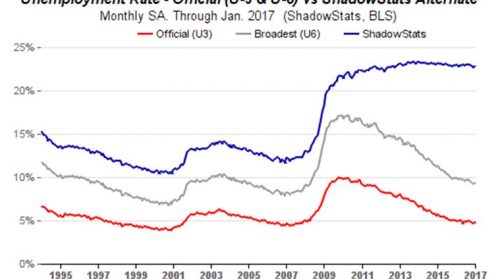PUBLIC COMMUNIQUE of our monthly bulletin GEAB February, 2017. Subscribe here !
Within the global systemic crisis that we are now experiencing, our experts have been talking for some years about “statistical fog” to qualify the inability of today’s tools to measure real economy, or even the way to manipulate them in order to match results to the political speech (or vice versa). Leaving aside the temptation to manipulate, this “statistical fog” also derives from the fact that the economy is evolving profoundly, and yesterday’s indicators (GDP, unemployment, etc.) are no longer relevant in today’s world. After a few vain attempts to transform these old time indicators, we are able to see new initiatives which we anticipate to be sustainable this time, and which in the short term will form some confusion before harmonizing themselves by 2025, pushed by international bodies such as the G20.
Limitations of the two flagship indicators
The debates or proposals made within electoral campaigns show this sufficiently: only the GDP growth rate on the one hand and the unemployment rate on the other seem to count. This is hardly surprising in a system where work, as well as the increase in “wealth”, are both central. These two indicators have guided politicians for many decades and in many ways with quite satisfactory results. Nevertheless, if every growth point is more and more difficult to reach and the unemployment rate constantly stays so high, it is with a reason. Society is radically changing and these two indicators, which do not reflect those evolutions, are becoming obsolete. We shall see that their limitations have several causes: statistical on the one hand, political or ideological on the other, but above all and more fundamentally, those indicators do not originally measure the harmonious development of societies[1]…
They are so emblematic that they are obviously subject to intense political pressure and are constantly the subject of international comparisons. And here the first problems arise. How to compare economies using different currencies, the exchange rates of which are extremely volatile[2]? We have already seen the perverse effects linked to the use of a single standard, the dollar: here we have a new illustration of that. Thus, the United States is by far the largest country for its nominal GDP expressed in dollar terms, while being behind China in purchasing power parity (PPP).
Fig. 1 – The countries GDP on a PPP Basis, 2014. Source: The Conversation.
Another example is how to objectively compare GDP growth in the United States, with a population growth of 0.7% per year[3], with that of the euro zone, where the population grows by only 0.3% per year[4]? Or why compare per capita incomes between countries where essential services such as education or health are costly, and those where they are free?
With regard to the unemployment rate, comparisons are even more difficult because the calculation methods between countries differ considerably. We regularly quote the ShadowStats site for its alternative calculation of the US unemployment rate, most certainly more faithful to the “reality” (at least that’s what the majority of Americans feel): it gives a singularly different image of the US labour market…
Fig. 2 – The unemployment rate in the US. Red: official / Grey: U6 / Blue: ShadowStats.
Source: ShadowStats.
In the case of the unemployment rate, statistics do not measure what they purport to measure (or rather what is commonly meant by “unemployment”) and are, therefore, pretty misleading. The same goes for the GDP, which is only a poor reflection of the “wealth” of a nation. This is all the more damaging when they serve as a guide for economic policies, such as wage moderation in Germany to the detriment of its European partners, or the Irish tax dumping to attract multinationals…
Subscribe and read more in the GEAB 112
The article contains the following chapters as well:
The world before versus the world after
Initiatives which are less and less vain
Slowly towards global standardisation
_____________________________________________________
Notes:
[1] We cannot resist the temptation to share with you this well-known GDP quotation of Robert Kennedy, made in 1968 : « it measures everything, in short, except that which makes life worthwhile ».
[2] For your information, the US dollar was worth 0,62 euro at the end of 2008, and is worth 0,94 now… meaning a 50% variation!
[3] Source: Wikipedia
[4] Source: Trading Economics


 LEAP2040 Toutes les informations et archives Europe2040
LEAP2040 Toutes les informations et archives Europe2040





